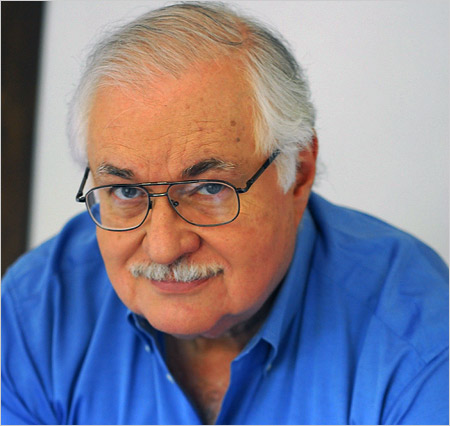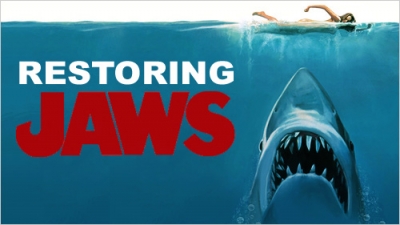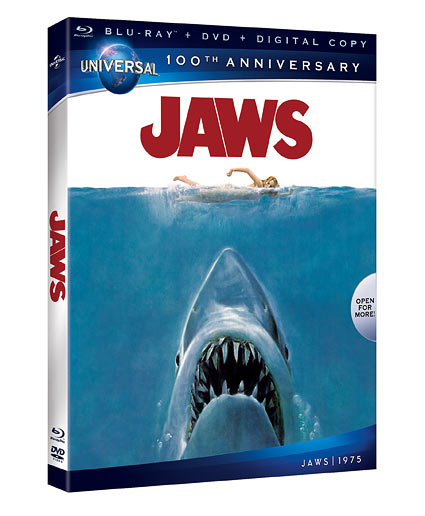The genesis on Jaws began on the page from author Peter Benchley and made it its way through the hallways of Universal Studios while the book was still in galley form. Producers Richard Zanuck and David Brown had a hunch, bought the rights and then put their faith in a young filmmaker by the name of Steven Spielberg to bring the book to cinematic life.
In an exclusive for The Digital Bits, I visited Universal Studios' famous Jaws Lake to interview Joe Alves, production designer on the original movie, and three people responsible for the restoration and content on the new Blu-ray.
Alves was among the first people hired for the movie. "I came to work on Jaws very early on, probably the first person on the movie, before Steven got involved," he said. Alves became an obvious choice after working with Spielberg on his first theatrical movie The Sugarland Express. Alves produced some illustrations to show the studio what the movie might look like. That's when Spielberg signed on to direct the movie.

Alves began storyboarding the movie while coordinating things, building the sets and the boats and finding a location for filming the movie (Martha's Vineyard). The biggest issue always centered on the shark effects. Spielberg and Alves agreed not to use miniatures and instead build a full size shark, one that looked like it could break a boat in half. And it had to be used in the ocean. They referenced old movies like The Old Man & the Sea which "was a good movie but the backdrop didn't look good," he said.
"The effects department here said it would take two years to build the shark and that wasn't acceptable," said Alves. "So they asked me, the head of the production, if I could see if I could get the shark built someplace else." He found Bob Mattey, who was retired from Disney, to build a mechanical shark in a very short time. "They gave Bob Mattey five months so he really didn't have proper testing time," he said. "He was doing it a quarter of the time that everybody else said they needed."
Meanwhile, Alves convinced Ron & Valerie Taylor to shoot footage of real sharks in Australia that eventually were seamlessly blended with the production footage. "The real shark got caught in the breakaway cage and that looked good but (actor Richard) Dreyfuss or the character Hooper was supposed to get killed, eaten by the shark, but there was no person in there," he said. "The footage was so good that they rewrote the script so Hooper lives in the story."
Back in the U.S., time became an issue waiting for the mechanical shark (nicknamed Bruce after Spielberg's lawyer), to start working properly. "The rest was just waiting to get the shark to work," said Alves. "We knew it would work. We just needed proper testing time."
The problem with the mechanical shark grew as salt water in the ocean ate into the electrical parts creating constant repairs. There were other elements: coordinating the shark and the boats shooting on the ocean, the unpredictable weather and other boats sailing by the camera shots. "We really needed another year and we didn't have that time," said Alves. "They just forced us to shoot an ocean movie in the spring back east in the cold water."
When asked how Jaws compared with other movies he worked on, Alves said, "Well, there's no comparison. Generally, as a production designer, you don't have those problems." It turned out to be a much bigger responsibility than Alves ever imagined. "That was quite different than other movies that I've done where you're primarily, like in Close Encounters, building big sets and things like that," he said. But there is no doubt that Alves counts Jaws as one of his biggest highlight in his long career.
Carl Gottlieb was a huge contributor to Jaws as the screenwriter working with Spielberg on set, an actor in a small supporting role and as an author for his book The Jaws Log. He detailed his experiences on the famous thriller in his book providing a fascinating behind the scenes peek at the making of a major motion picture, something not common back then. "The thing that I tried to do was a normal backstage making of, a journal, but at the same time, I wanted to put it in a larger context so that when you finished the book you not only knew how Jaws was made but how movies were made," he said.

What has made The Jaws Log different is its straight reporting from the set and not as a promotional tool for the studio. "No, I mean I can't write a puff piece," he said. "It was a chance to write kind of unrestrained and I made my own deal with the publisher. I didn't work for the studio," said Gottlieb. This allowed the author a certain degree of independence that makes for a great read even today.
How does Jaws look on Blu-ray? In a word, spectacular. Six times the resolution of the DVD, the Blu-ray offers an amazing visual treat for fans putting them on the boat alongside the three men in the second half of the movie.
The restoration process was overseen by Mike Daruty, senior vice-president of Universal Technical Operations. It took close to five months to restore Jaws to its former glory and better. "For Jaws, we evaluated our elements to determine if the original negatives would give us the highest quality," he said. The team at Universal scanned the original negatives, performed color correction and digitally fixed dirt and scratches frame by frame.

The goal was to restore the movie to look as Spielberg intended in 1975 but at a higher resolution. But rest assured, no changes were made to the film. "We did not add or delete any content," said Daruty. "We did not digitally enhanced or change anything. We really wanted this to be like the original version that went out, just at a higher resolution."
Daruty said Spielberg was brought in to review the restoration and "commented that the film never looked this good in its original release." "That's a testament to how good the quality is," he added. With bigger television sets and higher resolution monitors and screens, Daruty said the aim was to provide the best experience. "We really truly want to give them something that's of the highest quality."
And the Blu-ray does not disappoint offering a perfect blend of special features, including a great fan-produced feature-length documentary by Michael Roddy, producer of The Shark is Still Working. It started out with five guys wanting to make a documentary about their favorite film for the fans. "It was a film that we all loved," he said. "What we wanted to do with The Shark is Still Working is not necessarily look so much at the production but look at the impact and legacy of this film."
Roddy said it is a dream come true to be able to contribute to the definitive home video version of the movie. "We wanted to explore the stories that we were hearing as Jaws fans that maybe other people hadn't heard and we wanted to share that," he said. "It kept growing and growing." The movie inspired many people to become filmmakers, go into marine biology or even shark conservation. "It really is a positive story, all because of this simple, amazing piece of entertainment and that's a great thing," he said.
It took five years to put together the documentary beginning in June 2005. "When you produce something on your own without a production house, with your own funds, traveling around the country, editing in between your day job, it takes time," he said. The first cut of the documentary was three hours long, exhaustive but not entertaining. He and his team attended film festivals to get feedback which helped in the editing process. "We were able to really trim the fat and get it to a lean one hour and forty-eight minutes, which is a feature-length documentary," he said. "This is everything we wanted to say about Jaws," he added. "This is all the good stuff."
Roddy's fan-produced documentary is only one of the many tasty morsels on the Jaws Blu-ray. The biggest catch is Laurent Bouzereau's detailed two-hour documentary that covers every aspects of production from the location scouting and decisions on special effects through the challenging production and the difficulty of filming on an actual ocean. It is one of the best making-of documentaries on Blu-ray.
The Blu-ray also offers deleted scenes, storyboards, production photos, a short on the process of the restoration and a fascinating vintage featurette from 1974, life on the set of the movie. The Blu-ray contains UltraViolet, a new program that allows viewers to download and stream the movie to a computer, tablet or smartphone.
The Jaws Blu-ray looks and sounds better than ever to the point where you will really feel like you're on that boat in the middle of nowhere facing this giant creature....
- Mario Boucher
For more about the restoration, watch this featurette - it's also available on the Blu-ray.
You can order the Blu-ray from Amazon.com by clicking on this cover image. The disc streets on 8/14. Be sure to read our in-depth review of Jaws on Blu-ray here.



